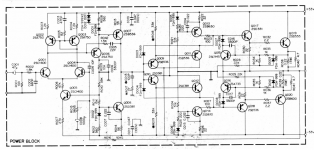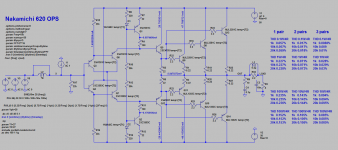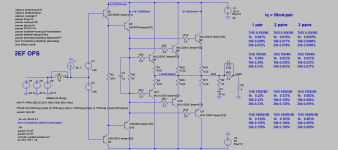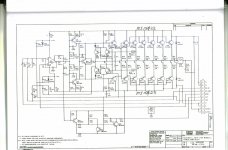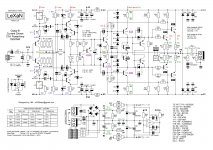I have a question on the schematic attached. It's a Nakamichi 620 power amplifier. Could anybody help to clarify me whether it is a Class B amplifier? Is it interesting to clone? Also, could anybody suggest me some examples of commercial Class B amplifiers?
Attachments
According the DS it is a current driven output stage with idle current of 20-30mA (Class-A region).
NAKAMICHI 620 SERVICE MANUAL Pdf Download | ManualsLib
NAKAMICHI 620 SERVICE MANUAL Pdf Download | ManualsLib
I see four emitter followers in succession in each branch of the push-pull output stage.According the DS it is a current driven output stage
Last edited:
So it is not a current driven output stage.yes, and ? pnp pnp npn npn ( upper half )
it is written in manufacturer's service manual, read, post #2, pages 4,5
I did not claim it is CD
imho, neither CD nor Class-B
I know what they were thinking, current-driven from VAS.
I did not claim it is CD
imho, neither CD nor Class-B
I know what they were thinking, current-driven from VAS.
Last edited:
Most amplifiers work in class B, that means having an optimized bias for the lowest crossover distortion.I have a question on the schematic attached. It's a Nakamichi 620 power amplifier. Could anybody help to clarify me whether it is a Class B amplifier? Is it interesting to clone? Also, could anybody suggest me some examples of commercial Class B amplifiers?
I suggest you read this Douglas Self's book :
The Audio Power Amplifier Design Handbook
The output impedance of the VAS is not so high and the input impedance of the followers are not so low that we can speak of current driven.it is written in manufacturer's service manual, read, post #2, pages 4,5
I did not claim it is CD
imho, neither CD nor Class-B
I know what they were thinking, current-driven from VAS.
The output stage looks a bit like a "diamond" (NPN loaded by CCS + PNP) and (PNP loaded by a CCS + NPN) as introduced by Audio Research first solid state amplifiers, I think, but here with more devices.
For a bit less distortion, the emitter resistors of Q017 and Q018 should not be connected to the output rail.
It is a class B output stage driven by a class A driver stage, as the documentation says repeatedly.
Annoying discussion, A or A / B or B or C or...🙄
There are technicians who claim that real class-B does not exist because the transistor characteristics do not allow for a clear classification. Consider infinitesimal calculus.
Ultimately, the vast majority of so-called class B amplifiers are either class AB with a very low quiescent current, or they are class C constructions such as B. current dumping.
There are technicians who claim that real class-B does not exist because the transistor characteristics do not allow for a clear classification. Consider infinitesimal calculus.
Ultimately, the vast majority of so-called class B amplifiers are either class AB with a very low quiescent current, or they are class C constructions such as B. current dumping.
Does anyone know the examples of commercial class B amplifier?
BGW systems mfrm-07200:
Attachments
Practically all solid state power amplifiers are class B.Does anyone know the examples of commercial class B amplifier?
Practically all solid state power amplifiers are class B.
This is different from what I've heard. I've heard that most SS power amplifiers are class AB. Class B is produced in a very small number. Nakamichi 620 may be one of them.
Many people say there is much distortion produced by Class B, but I'm interested to this class after I've heard the Nak 620 and want to listen to other class B amps.
not commercial but my diy class-b, current driven outputs, distortion 0.00x, good harmonics profile
Low distortion current driven Class-B output stage
measurements
Low distortion current driven Class-B output stage
Low distortion current driven Class-B output stage
measurements
Low distortion current driven Class-B output stage
Attachments
Last edited:
It depends on what exactly you mean by AB and B. Some people use AB to describe a stage just biased into 50% conduction, based on the fallacy that class B means unbiased. Others use it to describe a stage with 180 degrees conduction angle. I am in the latter camp, along with Douglas Self and every RF engineer on the planet. And, apparently, Nakamichi.
Last edited:
- Home
- Amplifiers
- Solid State
- Class B Amplifier
